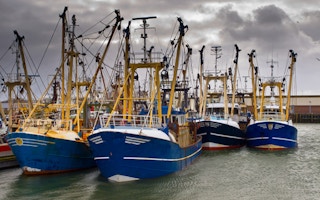The ocean is a big place, but not all seas are created equal. While 58% of the seas are classified as “high seas,” and open to access from all nations, there are over 150 exclusive economic zones (EEZs), which are the sole domain of the countries that operate them. EEZs comprise the remaining 42% of the ocean. The patchwork quilt of economic interests that blanket the ocean pose a problem for the fish who live there and the fisheries that exploit those fish.
As recently as the 1950s, most global fish stocks were maintained at healthy levels, but as fishing technology improved, many species were systematically overexploited. In a recent issue of PLoS Biology, researchers Crow White of Cal Poly San Luis Obispo and Christopher Costello of UC Santa Barbara, use a mathematical model and ideas from game theory to argue that the best way to recover dwindling stocks of high-value migratory pelagic species like tuna is to completely close the high seas to fishing.
They begin their argument by pointing out that the open access nature of the high seas has led (predictably) to a tragedy of the commons, an “unregulated state of affairs in which individuals inefficiently compete for a shared, limited resource, resulting in its eventual ruin…fisherman will race to fish, drive stocks down, and compete away economic value.” That pattern is what has led high seas fisheries to overexploitation.
“
For decades, hundreds of attempts have been made at multilateral agreements primarily through regional fishery management organizations, which aim to coordinate fishing across EEZs and on the [high seas]. While some exceptions exist, these efforts are widely regarded as a failure
Crow White and Christopher Costello
In partial response to overfishing, in 1994 the United Nations Convention on the Law of the Sea (UNCLOS) created the EEZ system. Under the law, each coastal nation retains sovereign control over the waters 200 nautical miles from their own shorelines. They have the right to keep foreign fleets out, and they get to exclusively manage the fisheries within their jurisdiction. And for nations who have science-based fishing policies, local stocks have begun to rebound. But large migratory species, like the high-value tuna, billfish, and sharks, aren’t protected by EEZs, because their range it far too large. The EEZ system is therefore inefficient to protect those species from overfishing.
“In an ideal world, all nations would cooperate in the management of trans-boundary stocks,” White and Costello say. But we do not live in that world. “For decades, hundreds of attempts have been made at multilateral agreements primarily through regional fishery management organizations, which aim to coordinate fishing across EEZs and on the [high seas]. While some exceptions exist, these efforts are widely regarded as a failure.”
It’s worth pointing out that small marine protected areas, like EEZs, are also insufficient to protect those migratory pelagic species. And closing just parts of the high seas would simply displace fishing to other, non-closed parts.
Most people assume that completely closing the high seas to fishing would result in substantial economic losses, but does that conjecture hold up to empirical scrutiny?
White and Costello created a mathematical model that accounted for the fraction of a fish stock’s range covered by EEZs, the number of EEZs which is included in that species’ range, the biological parameters of the stock (such as reproduction or life expectancy), and so on, in order to better understand what would happen under various protection plans for the high seas.
It’s notable that the current status quo, in which the high seas are completely open and 42% of oceans are in EEZs, resulted in the worst outcomes for fisheries, both in terms of sustainability and economics. But the answer isn’t to simply enlarge the EEZs, because that just shifts the problem to one of overharvesting on the high seas to one of conflict between nations.
When their model allowed for a complete closure of the high seas, stocks increased throughout the oceans: 400% on the high seas and 30% within EEZs. That is, even though fishing would continue within the EEZs, stocks there would still increase. Monetary profit would more than double, and yield would increase by more than 40 percent.
How could profits and yield increase while simultaneously closing the high seas to fishing? It’s the combination of “elimination of the inefficient overexploitation on the [high seas]” and “enhanced coordination across EEZs incentivized by the spillover and protection of fish from the [high seas].” In addition, it costs less to manage fisheries operating closer to shore than in the high seas, which saves money. “Collectively, these factors raise profit (and yield),” White and Costello write, “beyond the loss from not fishing” the high seas.
It’s not a perfect plan. Some nations, such as Spain, China, and Japan, disproportionately fish the high seas, and they would suffer financial losses at least in the short term. But, the researchers say, that loss could be offset if they begin to fish within their own EEZs as global stocks rebuild. And this proposal raises the question of enforcement. Would the money spent on ensuring compliance outweigh the financial gains from closing the high seas?
It’s a variation on the classic prisoner’s dilemma thought experiment, played out on our planet’s oceans. The rules of the game are designed such that each individual from within a pair is best served by acting selfishly, leaving his or her partner to suffer. However, the most optimal solution for the combined pair is to cooperate. Can the nations of the world set aside their own selfish ends and work together to create a more sustainable future for global fisheries?
Source: White C. & Costello C. (2014). Close the High Seas to Fishing?, PLoS Biology, 12 (3) e1001826. DOI: 10.1371/journal.pbio.1001826.s007
Dr. Jason G. Goldman is a cognitive scientist and science writer based in Los Angeles. This post originally appeared in Conservation, a publication of the University of Washington.








